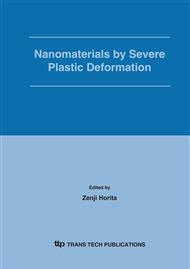p.877
p.883
p.889
p.895
p.901
p.907
p.913
p.919
p.925
Corrosion and Mechanical Behaviours of Cu-Cr In Situ Composites
Abstract:
The Cu-10vol.% Cr in situ composites were fabricated and their mechanical and corrosion properties were determined. For an equivalent amount of deformation, fcc-bcc composites have a much thinner effective fibre thickness and a much larger interfacial area than do fcc-fcc composite. The yield strength and the modulus of the composite decrease with temperature whereas the failure strain increases with temperature. The observed increase in failure strain with an increase in temperature from 22-600°C is as high as 333 %. Corrosion potential and rate in aerated hydro-sulfuric acid solution are -36.6 mVSHE and 3.525x10-3 A/cm2, respectively. Based on the electrochemical behaviors of the copper and chromium and observation of corrode surface, the corrosion mechanism of the copper-10% chromium composites in aerated hydro-sulfuric acid solution includes deallying mechanism in α-phase and galvanic corrosion at the interface between copper and chromium.
Info:
Periodical:
Pages:
901-906
Citation:
Online since:
January 2006
Authors:
Keywords:
Price:
Сopyright:
© 2006 Trans Tech Publications Ltd. All Rights Reserved
Share:
Citation:


